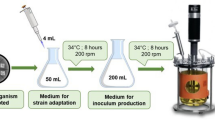Abstract
A pectinolytic bacterium was isolated from a mixed microbial population by means of a chemostat enrichment procedure. The bacterium, which was identified asErwinia carotovora, grew only on highly methylated pectin and produced a pectin lysase which released unsaturated monomer and dimer from 71% esterified citrus pectin. The pectin lyase was inducible only by pectins having a high methyl content and in pectin-limited chemostats its synthesis passed through a maximum at a dilution rate close to 0.04h-1.
Similar content being viewed by others
References
Buchanan, R. E., Gibbons, N. E.: Bergey's manual of determinative bacteriology, 8th ed. Baltimore: Williams & Wilkins 1974
Carter, B. L. A., Bull, A. T.: Studies of fungal growth and intermediary carbon metabolism under steady and non-steady state conditions. Biotechnol. Bioeng.11, 785–804 (1969)
Clarke, P. H., Houldsworth, M. A., Lilly, M. D.: Catabolite repression and induction of amidase synthesis ofPseudomonas aeruginosa 8602 in continuous culture. J. Gen. Microbiol.51, 225–234 (1968)
Cowan, S. T., Steel, K. J.: Manual for the identification of medical bacteria. Cambridge: Cambridge University Press 1970
Fogarty, W. M., Ward, O. P.: Pectinases and pectic polysaccharides. Prog. Ind. Microbiol.13, 59–119 (1974)
Fuchs, A.: The trans-eliminative breakdown of Na-polygalacturonate byPseudomonas fluorescens. Antonie van Leeuwenhoek31, 323–340 (1965)
Hasegawa, S., Nagel, C. W.: The characterization of an α, β unsaturated digalacturonic acid. J. Biol. Chem.237, 619–621 (1962)
Henderson, C., Hobson, P. N., Summers, R.: The production of amylase, protease and lipolytic enzymes by two species of anaerobic rumen bacteria. In: Proceedings of the Fourth Symposium on Continuous Culture of Microorganisms, pp. 189–204 (I. Malek et al., eds.). London: Academic Press 1969
Huber, T. J., Street, J. R., Bull, A. T., Cook, K. A., Cain, R. B.: Aromatic metabolism in the fungi. Growth ofRhodotorula mucilaginosa inp-hydroxybenzoate-limited chemostats and the effect of growth rate on the synthesis of enzymes of the 3-oxoadipate pathway. Arch. Microbiol.102, 139–144 (1975)
Lelliott, R. A., Billing, E., Hayward, A. C.: A determinative scheme for the fluorescent plant pathogenic Pseudomonads. J. Appl. Bact.29, 470–489 (1966)
Lowry, O. H., Rosebrough, N. J., Farr, A. L., Randall, R. J.: Protein measurement with the Folin phenol reagent. J. Biol. Chem.193, 265–275 (1951)
Perley, A. F., Page, D. T.: Differential induction of pectolytic enzymes ofFusarium roseum. Can. J. Microbiol.17, 415–420 (1971)
Rombouts, F. M.: Occurrence and properties of bacterial pectate lyases. Ph. D. Thesis, Agricultural University, Wageningen, The Netherlands (1972)
Rombouts, F. M., Pilnik, W.: Research on pectin depolymerases in the sixties; a literature review. C.R.C. Crit. Rev. Food Technol.3, 1–26 (1972)
Rowley, B. I., Bull, A. T.: A chemostat for the cultivation of moulds. Lab. Pract.22, 286–289 (1973)
Rowley, B. I., Bull, A. T.: Isolation of a yeast-lysingArthrobacter species and the production of the lytic enzyme complex in batch and continuous-flow fermenters. Biotechnol. Bioeng.19, 1260–1278 (1977)
Senior, E., Bull, A. T., Slater, J. H.: Enzyme evolution in a microbial community growing on the herbicide Dalapon. Nature, Lond.263, 476–479 (1976)
Tejerina, G., Portoles, A., Cabezas de Herrera, E.: Production de enzimas pectoliticas en cultivo continuo. Microbiol. Espan.20, 233–247 (1967)
Voragen, A. G. J.: Characterization of pectin lyases on pectins and oligogalacturonates. Ph. D. Thesis, Agricultural University, Wageningen, The Netherlands (1972)
Waravdekar, V. S., Saslaw, L. D.: A sensitive colourimetric method for the estimation of 2-deoxy sugars with the use of malonaldehydethiobarbituric acid reaction. J. Biol. Chem.234, 1945–1950 (1959)
Wieringa, K. T.: A method for isolating and counting pectolytic microbes. Proc. Fourth Int. Cong. Microbiol., Copenhagen, p.482 (1949)
Author information
Authors and Affiliations
Rights and permissions
About this article
Cite this article
Almengor-Hecht, M.L., Bull, A.T. Continuous-flow enrichment of a strain ofErwinia carotovora having specificity for highly methylated pectin. Arch. Microbiol. 119, 163–166 (1978). https://doi.org/10.1007/BF00964268
Received:
Issue Date:
DOI: https://doi.org/10.1007/BF00964268




